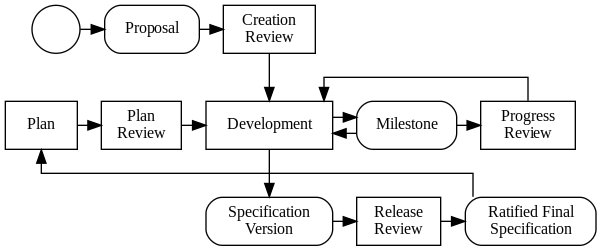It has been a lot of talk about processes in the Jakarta and MicroProfile community lately, so I just want to remind us all about this item from the Agile Manifesto.
Individuals and interactions over processes and tools.
https://agilemanifesto.org/
That said, some process is needed. Especially for work with specifications. In this post, I explain the Jakarta EE Specification Process and also think aloud about how the same principles could be applied to Eclipse MicroProfile.
The Jakarta EE Specification Process (JESP) is derived from the Foundation Specification Process (EFSP). The short version is that it specifies how long the voting periods (ballots) are for the various reviews:
- Creation Review: 7 days
- Plan Review: 7 days
- Progress Review: 14 days
- Release Review: 14 days
- Service Release Review: 14 days
The entire process is visualized in the figure below.

So, how fast can you develop a specification using the JESP?
Well, you will need to come up with a specification project proposal and submit it for review. This review may take up to 7 days to be finalized.
The next step is to present the release plan for the Jakarta EE Specification Committee for a Plan Review. This step is optional and meant as a means for the project to secure that you are on the right track. Let’s say we opt-in for this review which means another 7 days, i.e. 14 in total so far.
When your specification is ready to be released, you will submit it for a release review. This will take 14 days to complete and may run in parallel with the ratification by the Jakarta EE Specification Committee. The total amount of days in review for your specification will then be 28 days.
Without the plan review, we are looking at 21 days which is exactly the same as for any project following the Eclipse Development Process (EDP). Which applies to the e.g. the Eclipse MicroProfile project.
The difference between the governance model of Jakarta EE and Eclipse MicroProfile is that Jakarta EE is a working group and has a specification process in place for capturing the intellectual property before a specification is released. Whereas Eclipse MicroProfile is a standard Eclipse Foundation project with an ad-hoc specification process. As an Eclipse Foundation project, the project name has to be prefixed with Eclipse. As a working group, this restriction does not apply.
In the table below, I have summarized some of the similarities and differences and even taken the liberty to draw up how it could look like if a MicroProfile working group with its own specification process was established.
| Jakarta EE | Eclipse MicroProfile (as a project) | MicroProfile (as a working group) | |
| Specification Process | JESP | no | MSP (*) |
| Development Process | EDP | EDP | EDP |
| Release Review | 14 days | 14 days | 14 days |
| Ratification | yes | no | yes |
| Working Group | yes | no | yes |
| Project Names | Jakarta [spec] | Eclipse MicroProfile [spec] | MicroProfile [spec] |
| Specs Consumable by Jakarta EE | yes | no | yes |
| Specs Consumable by Eclipse MicroProfile | yes | yes | yes |
(*) Thinking aloud: MicroProfile Specification Process (MSP)
The MicroProfile Specification Process could be as simple as this: Adopt the EFSP with the following voting periods (ballots):
(…still thinking aloud…)
- Creation Review: 7 days (as today according to the EDP)
Plan Review: 7 days(or optional as today)- Progress Review: 7 days
- Release Review: 14 days
- Service Release Review: 14 days
To sum up, I think the JESP has captured the essence of “Individuals and interactions over processes and tools” by being as lightweight as possible while still protecting everyone involved.




